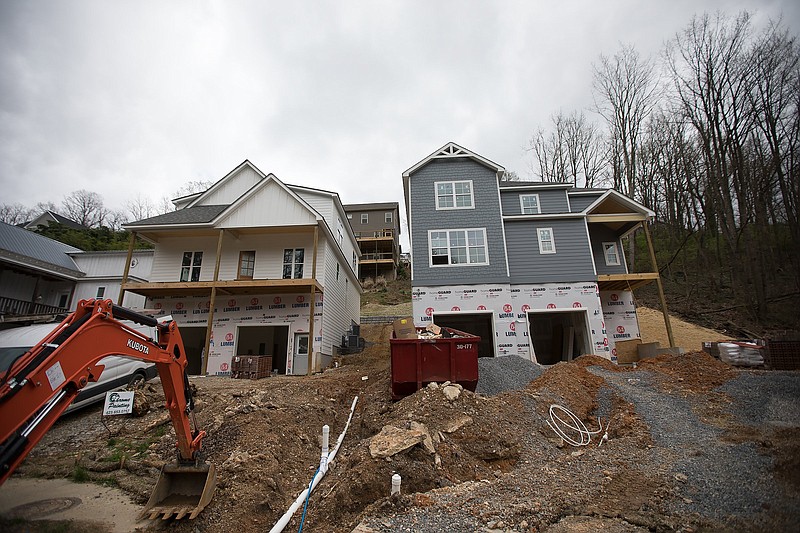In government, at least, things move slowly in Chattanooga, Tennessee.
In November of 2018 - about a year and a half ago - we found ourselves writing about Chattanooga developers having fits about a proposal to limit or at least better regulate building on our city's steep slopes and ridges. We quoted a Times Free Press story in which a spokesman for builders decried to Chattanooga City Council members that a proposed slope zoning rule "could possibly result in a de facto moratorium on development in the Chattanooga area." The proposal would allow grading or clearing on no more than 20% of any property where the slope is 33 degrees or greater.
Here we are in the spring of 2021 and the council has finally put a version of that proposal in ordinance form on the March 30 agenda.
Developers are still histrionic: Doug Fisher, the Home Builders Association of Greater Chattanooga's executive officer, told the Times Free Press last week that city planners' 2019 steep slopes assessment - the same one driving what proponents are calling today's "watered down" regulation - "a significant overreach of government authority."
But do you know what absolutely, positively doesn't move slowly in Chattanooga?
The often-torrential rainfall of our region.
It is the same unrelenting rainfall that for eons carved out our hillsides, ridges and mountains to form the Tennessee River and its tributaries.
Those hills and ridges, with an almost rain-forest lush of trees and plantings to hold at least some soil from erosion, tame our average 52-plus inches of yearly rain and give our city the stunning natural beauty we seem determined to despoil for a buck.
But when the earthmovers gouge away that green and start laying down rootless houses by the megatons, there's no place to hide from the deluge. Look no further than the landslide that closed the Bachman Tunnels for a couple of days last week in East Ridge. And last year, mud slides knocked out the power for several homes along Signal Mountain Road. The year before that, a Subway restaurant across the same road was crushed beneath a landslide from another ridge.
Even in 2018, planners tallied that the city's stormwater violations had more than doubled over the previous six years, according to the city's land development office. They found that 83% of the 597 rezoning cases reviewed by the Chattanooga-Hamilton County Regional Planning Agency had been for steep slopes, flood plains or both.
Take those figures and imagine the rest of ridges in the city covered with homes and apartment complexes - housing that few in Chattanooga could afford and housing that would change the view and feel of Chattanooga.
Now close your eyes and try to imagine the torrents of new rainfall runoff that will be inevitable as water pours off all those rooftops onto dead ground where once there were trees and shrubs to soak up much of the flow.
No, this is not an easy issue. Not an easy question - and certainly not an easy answer.
Chattanooga is growing and it needs affordable housing. Affordable won't happen on steep slopes. Even if the council OKs the "watered down" regulation. Fisher says home prices will rise still higher, and he wields the proposed slopes regulation like a club to back down the council.
"It could be in the thousands of dollars easily," he said. "Engineering is not inexpensive. Then the requirement for various types of vegetation could get very expensive."
On the other hand, setting 33% as the grade threshold (same as proposed in 2018) means 90% of the city's slopes won't be covered by the proposed ordinance, and the measure will actually apply to only about 10% of vacant parcels in the city.
Chattanooga-Hamilton County Regional Planning Agency figures show that if the grade threshold were set at 25%, more typical in other cities, the ordinance would affect 60% more parcels and 32% more acreage. If the threshold were set at 20%, the ordinance would impact 128% more parcels and 85% more acres.
Our council - our city - needs an intervention to help our leaders pull themselves away from bullying developers.
We've seen the builders' and developers' manipulations play out before. In the fall of 2017, they pushed the council to ease a standard for stormwater runoff retention put in place four years before along the extremely flood-prone South Chickamauga Creek. Never mind that Chattanooga already is under a federal EPA ruling to halt combined sewer and stormwater runoff overflows that is costing about $400 million. And never mind that with almost every new house built, we add to our sewage and runoff headaches.
Certainly there are cost trade-offs of some kind for living anywhere. In Atlanta, development cost is driven up in part by not having enough water. In Chattanooga, it's driven up in part by too much water.
We can't change our rainfall, but we can limit development on our ridges and slopes.
We'll pay for it either way: Either by paying it forward and growing responsibly or by paying for our corner-cutting mistakes - again and again. Which will it be, council members? Smart growth or dumb growth?
